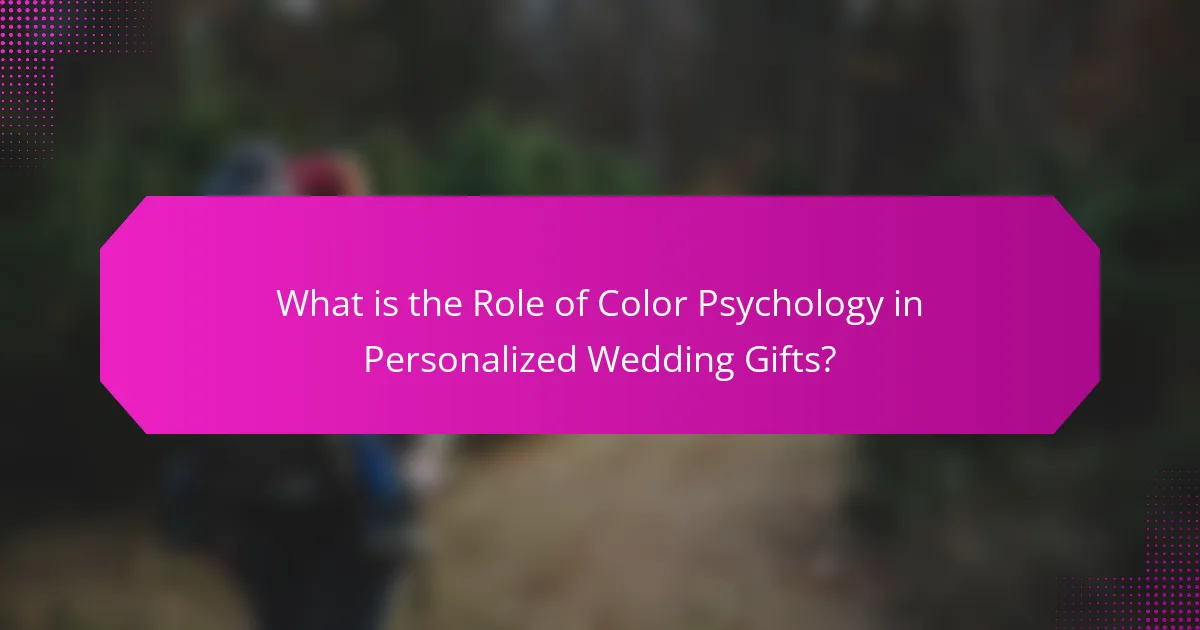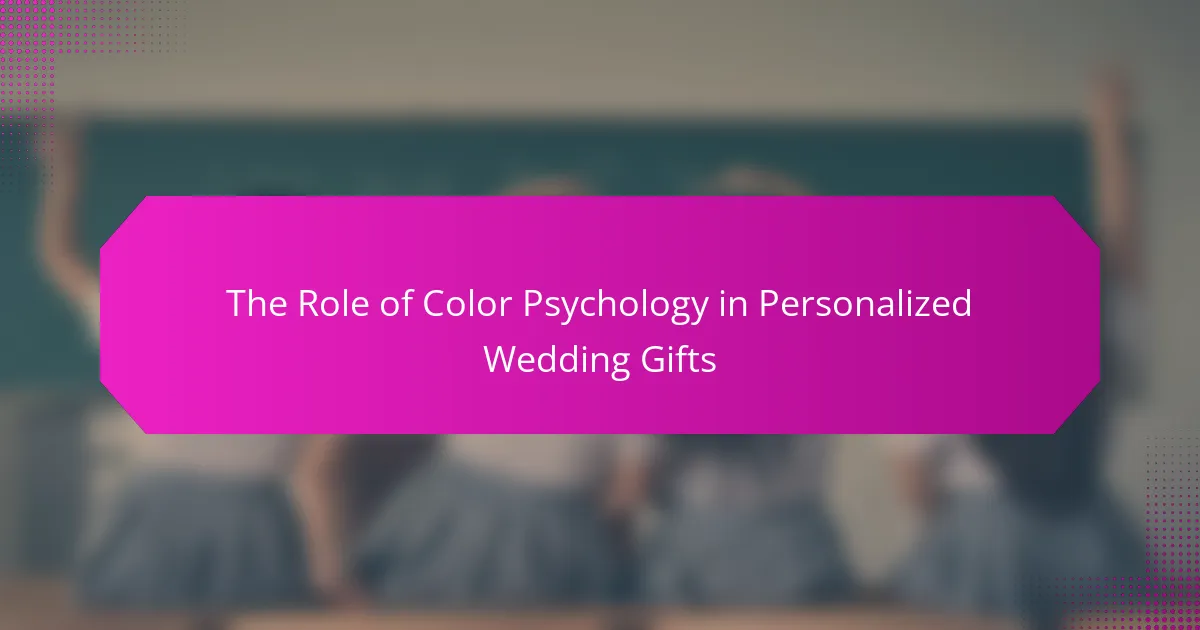Color psychology significantly influences the perception and emotional response to personalized wedding gifts. Different colors evoke specific feelings and associations; for instance, red signifies love and passion, while blue conveys calmness and trust. Research indicates that color can enhance decision-making and emotional connections, with studies showing that color choices can increase brand recognition. Understanding these principles is essential for selecting meaningful colors that enhance the memorability of wedding gifts, ultimately creating a more thoughtful and personalized experience for recipients.

What is the Role of Color Psychology in Personalized Wedding Gifts?
Color psychology plays a significant role in personalized wedding gifts. It influences how recipients perceive and feel about their gifts. Different colors evoke specific emotions and associations. For example, red symbolizes love and passion, making it a popular choice for wedding gifts. Blue often represents calmness and trust, suitable for items like home decor. Green is linked to growth and harmony, ideal for gifts that promote wellness.
Research shows that color can impact decision-making and emotional responses. A study by Satyendra Singh in the journal “Management Decision” found that color increases brand recognition by 80%. This principle applies to personalized gifts, where color choices can enhance emotional connection. Choosing the right color can make a gift more memorable and meaningful. Thus, understanding color psychology is essential for creating thoughtful and personalized wedding gifts.
How does color psychology influence gift selection for weddings?
Color psychology significantly influences gift selection for weddings. Different colors evoke specific emotions and associations. For example, red symbolizes love and passion, making it a popular choice for romantic gifts. Blue often represents calmness and trust, ideal for gifts aimed at fostering harmony. Yellow conveys happiness and cheer, suitable for celebratory items.
Research indicates that color can affect consumer behavior. A study by Satyendra Singh in the “Management Decision” journal found that color increases brand recognition by up to 80%. This suggests that selecting gifts in colors aligned with the couple’s preferences or wedding theme can enhance emotional impact.
Using color psychology in gift selection helps create a thoughtful and personalized experience. It ensures that the gifts resonate emotionally with the recipients, reinforcing the significance of the occasion.
What are the psychological effects of different colors?
Colors can significantly influence emotions and behaviors. For example, red often evokes feelings of passion and energy. Blue tends to promote calmness and trust. Yellow is associated with happiness and optimism. Green represents balance and tranquility. Purple is linked to creativity and luxury. Each color can elicit specific psychological responses. Research has shown that color can impact mood and decision-making. A study published in the Journal of Experimental Psychology found that colors can affect consumer behavior. This demonstrates the importance of color choice in personalized gifts, especially for weddings.
How do cultural perceptions of color affect wedding gift choices?
Cultural perceptions of color significantly influence wedding gift choices. Different cultures attribute distinct meanings to colors. For example, in Western cultures, white symbolizes purity and is often associated with weddings. This leads to gifts like white linens or porcelain.
In contrast, red is considered auspicious in many Asian cultures. It signifies good fortune and happiness. Therefore, gifts in red packaging or red-themed items are common in weddings within these cultures.
Additionally, the color blue is often linked to tranquility and harmony in various cultures. Gifts that incorporate blue may be chosen to promote peace in the couple’s new life together.
These color associations guide gift selections, reflecting cultural values and traditions. Understanding these perceptions helps gift-givers choose appropriate and meaningful presents.
Why is personalization important in wedding gifts?
Personalization is important in wedding gifts because it enhances emotional significance. Customized gifts demonstrate thoughtfulness and consideration for the couple’s unique story. This tailored approach fosters a deeper connection between the giver and the recipients. Research shows that personalized gifts are often perceived as more meaningful. According to a study by the Journal of Consumer Research, personalized items can increase emotional attachment. This attachment can lead to greater appreciation and satisfaction with the gift. Overall, personalization transforms a standard gift into a cherished keepsake.
How does personalization enhance the emotional value of a gift?
Personalization enhances the emotional value of a gift by creating a deeper connection between the giver and the recipient. Customizing a gift shows thoughtfulness and consideration for the recipient’s preferences. This tailored approach makes the gift feel unique and special. Research indicates that personalized gifts evoke stronger emotional responses compared to generic ones. According to a study published in the Journal of Consumer Research, personalized gifts are perceived as more meaningful and memorable. This emotional resonance can strengthen relationships and foster lasting memories. Personalization transforms an ordinary gift into a cherished keepsake.
What are the common methods of personalizing wedding gifts?
Common methods of personalizing wedding gifts include engraving, monogramming, and custom messages. Engraving involves carving names or dates onto items like glassware or jewelry. Monogramming typically adds initials to textiles such as towels or linens. Custom messages can be printed or written on cards or gift items, allowing for personal sentiments. Other methods include photo printing on gifts or creating custom artwork. These personalization techniques enhance the sentimental value of gifts. Personalization is a popular trend, as it makes gifts more meaningful for couples.
What role do colors play in the personalization of wedding gifts?
Colors significantly influence the personalization of wedding gifts. They evoke emotions and convey meaning. For instance, red symbolizes love and passion. Blue often represents tranquility and loyalty. These associations allow gift-givers to tailor their presents to the couple’s preferences. Personalized gifts in favored colors can enhance emotional connection. Research indicates that color can affect perceptions and feelings, making gifts more memorable. By considering color psychology, individuals can create more meaningful and thoughtful wedding gifts.
How can specific colors be chosen to match the couple’s personality?
Specific colors can be chosen to match a couple’s personality by analyzing their individual traits and preferences. Color psychology suggests that colors evoke emotions and convey meanings. For example, blue often represents calmness and trust, while red symbolizes passion and energy. Couples can discuss their favorite colors and what those colors represent to them. They can also consider how colors make them feel in different contexts. Additionally, they can look at their shared experiences and memories associated with certain colors. This method ensures that the chosen colors resonate with their unique personalities.
What are the best color combinations for personalized wedding gifts?
The best color combinations for personalized wedding gifts include navy blue and gold, blush pink and rose gold, and emerald green and cream. Navy blue and gold convey elegance and sophistication, making them popular choices for formal weddings. Blush pink and rose gold create a romantic and soft aesthetic, suitable for intimate celebrations. Emerald green and cream provide a fresh and timeless look, appealing to nature-inspired themes. These combinations resonate with couples’ emotions and enhance the significance of the gifts. Color psychology suggests that these hues evoke feelings of love, joy, and tranquility, aligning with the wedding’s celebratory nature.
How can understanding color psychology improve gift-giving experiences?
Understanding color psychology can enhance gift-giving experiences by influencing emotional responses. Different colors evoke specific feelings and associations. For example, blue is often linked to calmness and trust, while red can signify love and passion. By choosing colors that align with the recipient’s personality or the occasion, the giver can create a more meaningful connection. Research indicates that color can impact perceptions of gifts; a study published in the Journal of Consumer Research shows that well-chosen colors can increase the perceived value of a gift. This understanding allows for more thoughtful selections, ultimately leading to greater satisfaction for both the giver and the recipient.
What strategies can be used to effectively incorporate color psychology in gift selection?
To effectively incorporate color psychology in gift selection, identify the emotional responses associated with colors. For example, red evokes passion, while blue signifies calmness. Next, consider the recipient’s preferences and personality traits. Tailoring the color to the individual’s character enhances the gift’s impact. Additionally, align the color scheme with the occasion. For weddings, soft pastels often symbolize love and harmony. Research indicates that colors can influence mood and perception, reinforcing the importance of thoughtful selection. Utilizing color psychology can lead to more meaningful and memorable gifts.
How can one evaluate the impact of color choices on the recipient’s emotions?
One can evaluate the impact of color choices on the recipient’s emotions through psychological studies and surveys. Research indicates that colors evoke specific emotional responses. For instance, blue often promotes calmness, while red can increase excitement. Conducting surveys can help gather individual emotional reactions to different colors. A study by Küller et al. (2009) found that color affects mood and behavior significantly. Analyzing participant feedback on color preferences can provide insights into emotional responses. Additionally, observing behavioral changes in response to color in real-life settings can offer empirical evidence. Overall, a combination of research and direct feedback is essential for evaluation.
What are some practical tips for choosing personalized wedding gifts based on color psychology?
Choose personalized wedding gifts by considering the recipient’s color preferences. Different colors evoke specific emotions and meanings. For example, red symbolizes love and passion. Blue represents calmness and trust. Green signifies growth and harmony.
Select gifts in colors that resonate with the couple’s personalities. Research indicates that color can influence mood and perception. A study by the Institute for Color Research found that people make a subconscious judgment about a person or environment within 90 seconds, based on color alone.
Incorporate the couple’s wedding colors into the gift design. This creates a cohesive and thoughtful presentation. Personalized items, such as monogrammed towels or custom artwork, can reflect these colors effectively.
Consider the context of the gift. A vibrant color might suit a lively couple, while softer tones may appeal to those with a more subdued style. Understanding color psychology can enhance the emotional impact of your gift.
The main entity of this article is color psychology in the context of personalized wedding gifts. The article explores how color influences emotional responses and perceptions, guiding the selection of gifts that resonate with the recipients. It discusses the psychological effects of different colors, cultural perceptions, and the importance of personalization in enhancing emotional significance. Additionally, it provides practical tips for choosing colors that align with the couple’s personality and wedding theme, ultimately emphasizing the role of color psychology in creating meaningful and memorable gifts.
